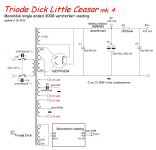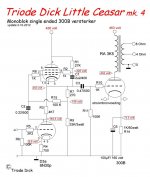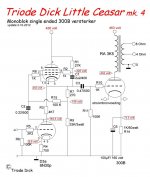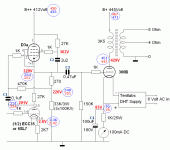Hello,
I confess I found this very scary for beginners: schematics should change for the component brands? Is there any advantage to use it that way or just because the BG's can be used like that?
On top of it the BG are getting more and more extinct...
What else depends on what make the component is?
Thanks to those who noted that...
Regards, Zuheyr
I confess I found this very scary for beginners: schematics should change for the component brands? Is there any advantage to use it that way or just because the BG's can be used like that?
On top of it the BG are getting more and more extinct...
What else depends on what make the component is?
Thanks to those who noted that...
Regards, Zuheyr
Ok, it's a dual polarity type; ...confusing ain't it.. really the nomenclature symbol should be the drawn/shown the same on both sides.
Since it's a polarised position, Can one really be convinced that a cheaper good quality lo ESR electrolytic as used in SMPS would sound just as good ? There's some good stuff about. Convince me that Blackgates are worth the dosh.
richy
Since it's a polarised position, Can one really be convinced that a cheaper good quality lo ESR electrolytic as used in SMPS would sound just as good ? There's some good stuff about. Convince me that Blackgates are worth the dosh.
richy
Seeking advice for selecting the right caps
I recently obtained most parts to build the Ceasar mk4, but some of the capacitors are missing. I'm seeking advice about suitable types of caps without spending enormous amounts of money on them.
The first cap needed is C6 (2.2uF 400V) for the PSU. The store that sells these amplifier kits offered me a Auricap (€26 each! ) for this position, but to me this seems a bit overkill. Maybe a WIMA cap will also do?
) for this position, but to me this seems a bit overkill. Maybe a WIMA cap will also do?
The second cap I need is C6 (100uF 160V) for the amplifier. I know that blackgates are being used for C6, but these are almost impossible to buy these days. Maybe a descent low ESR type cap would work here just as fine? Any suggestions?
The schematics are attached,
Thanks!
I recently obtained most parts to build the Ceasar mk4, but some of the capacitors are missing. I'm seeking advice about suitable types of caps without spending enormous amounts of money on them.
The first cap needed is C6 (2.2uF 400V) for the PSU. The store that sells these amplifier kits offered me a Auricap (€26 each!
The second cap I need is C6 (100uF 160V) for the amplifier. I know that blackgates are being used for C6, but these are almost impossible to buy these days. Maybe a descent low ESR type cap would work here just as fine? Any suggestions?
The schematics are attached,
Thanks!
Attachments
Last edited:
Since C6 is in the D3a heater I believe you are correct. I can’t think of an engineering need for an expensive audiophile cap here.
The 100 microfarad cap is in the signal path and suggest buying the best cap your budget would allow. I suggest you consider a film cap here. There are several resonably-priced film caps available in this value now (20 US$ range), or a motor-run cap, which should sound better than a BG electrolytic. Else, buy a good ‘lytic and bypass with a good film cap.
Good luck with your build, and post pictures and listening impressions, please.
The 100 microfarad cap is in the signal path and suggest buying the best cap your budget would allow. I suggest you consider a film cap here. There are several resonably-priced film caps available in this value now (20 US$ range), or a motor-run cap, which should sound better than a BG electrolytic. Else, buy a good ‘lytic and bypass with a good film cap.
Good luck with your build, and post pictures and listening impressions, please.
Questions and tips
I'm almost finished with building one channel, but before powering it up for the first time I have a few questions.
Any other pro tips with regards to testing a new build?
oh, I know that I shouldn't power up the amps without a (dummy) load connected.
I'm almost finished with building one channel, but before powering it up for the first time I have a few questions.
- It looks like that there is no bleeder resistor in the power power supply section, do I need to install it? What would be the best location for a bleeder?
- Is it OK to verify filament operation by removing just the rectifier tube?
- Is it safe to test the amp without the power and input tubes in place? According to my calculations B+ will see 537 Volts (380 x 1.414), which is higher than the rating of the PSU caps. Have I just answered my own question?
Any other pro tips with regards to testing a new build?
oh, I know that I shouldn't power up the amps without a (dummy) load connected.
Congratulations on finishing a channel of your new amp. Here are my thoughts on your questions. I hope others will chip in too.
1. I would paralel the main (2x100) capacitors with a bleeder resister. Note the last cap will reach the bleeder resistor via the 2k2 resistor and will descharge relatively slowly, even if it is only 10 mF
2. Yes, just remove the rectifier.
3. Without power tubes that are drawing current it would be best to use a variac to bring up the amplifier to keep B+ below 500VDC, say 475V. If everything looks good then power off, let the caps bleed down and plug in the tubes. If you don’t have a variac consider a bucking transformer to lower the voltage. The 500V caps will probably survive 530VDC for a short testing period, but personally I will not take that chance, if it could be helped.
Best wishes with bringing the amp to life. Let us know how you like its performance and what you hear.
1. I would paralel the main (2x100) capacitors with a bleeder resister. Note the last cap will reach the bleeder resistor via the 2k2 resistor and will descharge relatively slowly, even if it is only 10 mF
2. Yes, just remove the rectifier.
3. Without power tubes that are drawing current it would be best to use a variac to bring up the amplifier to keep B+ below 500VDC, say 475V. If everything looks good then power off, let the caps bleed down and plug in the tubes. If you don’t have a variac consider a bucking transformer to lower the voltage. The 500V caps will probably survive 530VDC for a short testing period, but personally I will not take that chance, if it could be helped.
Best wishes with bringing the amp to life. Let us know how you like its performance and what you hear.
The build is progressing slowly, but I'm getting there eventually.
I may have found a error in the original schematics. Pins 1, 2, 3 and 8 of the D3A tube are directly connected to each other in the original schematics, but this is not the case when looking at other implementations with the D3A and only pins 1, 3 and 8 are connected to each other.
I'm a bit in the dark here. Which implementation is correct?
edit:
The first attachment is the original schematic and I found the second attached schematics on Troels Gravesen his website
I may have found a error in the original schematics. Pins 1, 2, 3 and 8 of the D3A tube are directly connected to each other in the original schematics, but this is not the case when looking at other implementations with the D3A and only pins 1, 3 and 8 are connected to each other.
I'm a bit in the dark here. Which implementation is correct?
edit:
The first attachment is the original schematic and I found the second attached schematics on Troels Gravesen his website
Attachments
Last edited:
example for comparing
Yes in that view you are right.
But google is your friend.
So find pinout example for comparing what is right.
D 3a, Tube D3a; Rohre D 3a ID19218, Vacuum Pentode
EF 184, Tube EF184; Rohre EF 184 ID3431, Vacuum Pentode
Vinyl Savor has dismantled one to look to inner quality:
VinylSavor: Tube of the Month: The D3a
Jogi has placed a pdf - end of page to D3a.
Deutsche Behoerdenroehren / Postroehren - D3a
So you can have a clearer view, better as Dicks drawing in schematic.
in schematic.
Show some pics of glowing tubes if all worked properly.
Yes in that view you are right.
But google is your friend.
So find pinout example for comparing what is right.
D 3a, Tube D3a; Rohre D 3a ID19218, Vacuum Pentode
EF 184, Tube EF184; Rohre EF 184 ID3431, Vacuum Pentode
Vinyl Savor has dismantled one to look to inner quality:
VinylSavor: Tube of the Month: The D3a
Jogi has placed a pdf - end of page to D3a.
Deutsche Behoerdenroehren / Postroehren - D3a
So you can have a clearer view, better as Dicks drawing
Show some pics of glowing tubes if all worked properly.
> is the voltage measured from the plate to the heater (ie 450-75 = 375v)? Sorry but I am not so familiar with DHTs.
Yes, 375V. (How would the tube know where "ground" is? It does not have any finger or toe on ground.)
In this case it is the "filament", which also serves as the cathode. A "heater" is, strictly, the hot-up element inside an "indirectly heated" cathode. (Yes, online chat is often casual about these words.)
Yes, 375V. (How would the tube know where "ground" is? It does not have any finger or toe on ground.)
In this case it is the "filament", which also serves as the cathode. A "heater" is, strictly, the hot-up element inside an "indirectly heated" cathode. (Yes, online chat is often casual about these words.)
- Status
- This old topic is closed. If you want to reopen this topic, contact a moderator using the "Report Post" button.
- Home
- Amplifiers
- Tubes / Valves
- Ceasar II - HighEnd Tube Mono Block Project



